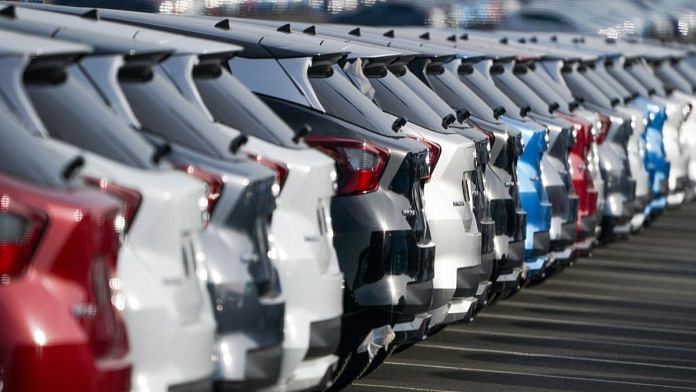Cars have really become expensive. You hear such complaints all the time. Across segments — from the entry-level Maruti Alto and Renalt Kwid to luxury German brands, cars are pricey in India. Part of the reason is of course the high levels of taxation on them. A Mercedes-Benz E-Class that would set you back $60,000 in the United States costs over $100,000 on road in India.
But that’s a medium-term story. In the long term, they have become affordable.
When my father bought his first car after moving to Delhi in 1987, it was a Maruti Van, and I remember seeing the invoice vividly, it cost the princely sum of Rs 58,000. The prices for the Van, which we know now as the Omni and the ubiquitous Maruti 800, which was still the original SS80 in 1987, were identical. No music system, no air-conditioner, nothing. Heck, there were no front seatbelts.
Also read: Maruti Suzuki missed out on the SUV party. But Grand Vitara, Invicto show it’s pulling hard
The fact even with a conservative estimate — based on an 8 per cent compound interest calculation — is that Rs 58,000 in 1987 would be around Rs 8.5 lakh of today, and while for that kind of money you might not get a big SUV anymore, you can easily get a top-spec Maruti-Suzuki WagonR or Hyundai i10 Nios with all the creature comforts you need. Or even the entry-level variant of the new Maruti-Suzuki Fronx. And while the cost of a basic entry-level Alto or Kwid has increased considerably, the cheapest variants of both cars cost a shade under Rs 4.5 lakh on the road. Think about that for a second. An entry-level car effectively costs half what such a vehicle did 35 years ago. Yes, the automotive industry has seen prices collapse like televisions for example.
But then again, taxes on cars have gone up, the Indian rupee has depreciated considerably and cars have also added features. It is not just touch-screen infotainment screens, your car emits exponentially lower emissions today than it did 35 years ago, when emissions control norms were not even thought of. And yes, while Maruti-Suzuki Chairman R.C Bhargava complains that safety norms have made cars more expensive and that new rules mandating six airbags in all cars will make them dearer, it would be difficult to argue that cars are less safe today than they were in the 1980s or 1990s. Yes, fatalities have dramatically gone up, but that is more a function of greater vehicular load on our roads and as a pure percentage, fatalities involving passenger cars are going down.
So why the complaints about car prices right now? When the prices for the new Maruti-Suzuki Jimny were announced just a few days ago, there were groans of despair among automotive enthusiasts on social media. The top-end model would cost in excess of Rs 17 lakh on the road (the exact on-the-road price of a car varies according to the state you register the vehicle in) but despite the slightly high price, Maruti-Suzuki did not see a rash of order cancellations. In fact, it saw its order book even go up slightly.
In July, multiple new Sports Utility Vehicles (SUV) will be launched such as the Honda Elevate and Citroen C3 Aircross, whose first drive impressions you will read in these columns. But do not expect these models to be ‘affordable’ and nor the facelift of the Kia Seltos. As the Jimny experience proved for Maruti-Suzuki, in certain segments at least, carmakers have pricing power and coupled with more features such as the ‘Honda Sensing’ that the Elevate will come with, they can charge more. Although, it also seems like a case of making hay while the sun shines.
But will the sun continue to shine so brightly? In a recent interaction with Executive Director, Sales and Marketing, Maruti-Suzuki, Shashank Srivastava said he expected growth for the auto industry on the whole to moderate in the current fiscal year to just 5-7 per cent. Although that would see the overall market smash past the 4-million unit sales mark. This is despite bottlenecks such as the semiconductor shortage largely being resolved. So why is that?
Also read: EVs are duping you about carbon emissions. Govt should let diesel cars run longer
One of course is production constraints. But when you talk to them privately, some automotive industry executives do admit that prices of entry-level products have made them unaffordable, especially for newer buyers. The additional costs of safety and meeting emissions norms, which will only increase with any future move to BS-7, have played a critical part in increasing prices and the robust demand in the Rs 15 lakh-plus segment has papered over some of the demand issues at the lower-end of the market. Niranjan Gupta, the new CEO at Hero MotoCorp — a company that was adversely impacted by the demand collapse at the lower-end of the market — tells me, “The massive outlay in infrastructure projects by this government will start paying dividends within a few quarters with increased economic activity. And that will include motorcycle sales and car sales.”
So it would appear that demand is going nowhere and waiting-lists for cars will remain robust even as growth moderates. There is an estimated 2.5 million units of additional carmaking capacity coming on stream by 2025 with new factories — Maruti-Suzuki’s unit at Kharkhoda and the revival of the old Ford and General Motors plants by Tata Motors and Hyundai Motors respectively. The automotive industry will continue to be an engine of Indian economic growth and employment. So before you watch silly YouTube by influencers demanding a ‘ban on cars’, think about this for a second as well.
And well, don’t expect car prices to moderate anytime soon.
@kushanmitra is an automotive journalist based in New Delhi. Views are personal.



